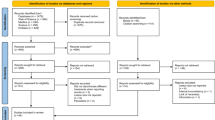Abstract
Objective To compare the effect of different endodontic access cavities on fracture toughness of extracted endodontically treated human teeth.
Data/sources An electronic literature search was performed in seven databases as well as hand search until September 2020. Risk-of-bias tool was used to evaluate the quality of included studies. Random effects frequentist network meta-analysis was performed, with mean difference (MD) and 95% confidence interval (CI) as the effect measure. Confidence in the documented evidence was assessed through the newly fuelled Confidence in Network Meta-analysis (CINeMA) framework based on the Grading of Recommendations, Assessment, Development and Evaluation (GRADE) approach.
Study selection A total of 844 articles were obtained in the electronic and hand search. After the application of the eligibility criteria and duplicate removal, 14 studies were included in this systematic review. All included studies were in vitro that evaluated the influence of conservative endodontic cavities (CECs) on fracture toughness in extracted endodontically treated human teeth and compared to traditional endodontic cavities (TECs). In total, ten studies (n = 456) were included in the network meta-analysis for molars. The overall risk of bias was moderate.
Results The results showed that when compared to intact teeth, the greatest reduction in fracture resistance was reported for TEC (MD: -927.52; 95% CI [-1304.80; -550.24]) and CEC showed least reduction in fracture resistance (MD: -365.59; 95% CI [-759.02; 27.83]). The surface under the cumulative ranking curve (SUCRA) value for intact teeth was highest (85.4% probability of being ranked as first), followed by CEC (51.4% probability of being ranked as second), with CEC presenting the highest probabilities to be the most effective access cavity design, according to the RANK (receptor activator of NF-kappaB) table. Level of confidence varied from low to moderate across all formulated comparisons.
Conclusion Overall, based on the included in vitro studies in this systematic review, CEC was the most favourable access cavity design when compared to other (truss access cavities, TEC and ninja cavities) and TEC was the least favourable for fracture resistance; however, the level of evidence was moderate.
This is a preview of subscription content, access via your institution
Access options
Subscribe to this journal
Receive 4 print issues and online access
$259.00 per year
only $64.75 per issue
Buy this article
- Purchase on Springer Link
- Instant access to full article PDF
Prices may be subject to local taxes which are calculated during checkout




Similar content being viewed by others
References
Vieira G C S, Pérez A R, Alves F R et al. Impact of contracted endodontic cavities on root canal disinfection and shaping. J Endod 2020; 46: 655-661.
Juan X, Wang W, Zhengmao L et al. Impacts of contracted endodontic cavities compared to traditional endodontic cavities in premolars. BMC Oral Health 2020; 20: 250.
Patel S, Rhodes J. A practical guide to endodontic access cavity preparation in molar teeth. Br Dent J 2007; 203: 133-140.
Zhang Y, Liu Y, She Y, Liang Y, Xu F, Fang C. The Effect of Endodontic Access Cavities on Fracture Resistance of First Maxillary Molar Using the Extended Finite Element Method. J Endod 2019; 45: 316-321.
Abou-Elnaga M Y, Alkhawas MB A M, Kim HC, Refai A S. Effect of Truss Access and Artificial Truss Restoration on the Fracture Resistance of Endodontically Treated Mandibular First Molars. J Endod 2019; 45: 813-817.
Krishan R, Paqué F, Ossareh A, Kishen A, Dao T, Friedman S. Impacts of conservative endodontic cavity on root canal instrumentation efficacy and resistance to fracture assessed in incisors, premolars, and molars. J Endod 2014; 40: 1160-1166.
Clark D, Khademi J A. Case studies in modern molar endodontic access and directed dentin conservation. Dent Clin North Am 2010; 54: 275-289.
Barbosa A F A, Silva E J N L, Coelho B P, Ferreira C M A, Lima C O, Sassone L M. The influence of endodontic access cavity design on the efficacy of canal instrumentation, microbial reduction, root canal filling and fracture resistance in mandibular molars. Int Endod J 2020; 53: 1666-1679.
Chlup Z, Žižka R, Kania J, Přibyl M. Fracture behaviour of teeth with conventional and mini-invasive access cavity designs. J Eur Ceram Soc 2017; 37: 4423-4429.
Clark D, Khademi J, Herbranson E. Fracture resistant endodontic and restorative preparations. Dent Today 2013; 32: 118-123.
Sarkis-Onofre R, Skupien J A, Cenci M S, Moraes R R, Pereira-Cenci T. The role of resin cement on bond strength of glass-fibre posts luted into root canals: a systematic review and meta-analysis of in vitro studies. Oper Dent 2014; DOI: 10.2341/13-070-LIT.
Silva E J N L, Rover G, Belladonna F G, De-Deus G, da Silveira Teixeira C, da Silva Fidalgo T K. Impact of contracted endodontic cavities on fracture resistance of endodontically treated teeth: a systematic review of in vitro studies. Clin Oral Investig 2018; 22: 109-118.
Owen R K, Bradbury N, Xin Y, Cooper N, Sutton A. MetaInsight: An interactive web-based tool for analysing, interrogating, and visualizing network meta-analyses using R-shiny and netmeta. Res Synth Methods 2019; 10: 569-581.
Nikolakopoulou A, Higgins J P T, Papakonstantinou T et al. CINeMA: an approach for assessing confidence in the results of a network meta-analysis. PLoS Med 2020; DOI: 10.1371/journal.pmed.1003082.
Papakonstantinou T, Nikolakopoulou A, Higgins J P T, Egger M, Salanti G. CINeMA: Software for semiautomated assessment of the confidence in the results of network meta-analysis. Campbell Syst Rev 2020; DOI: 10.1002/cl2.1080.
Guyatt G H, Oxman A D, Vist G E et al. GRADE: an emerging consensus on rating quality of evidence and strength of recommendations. BMJ 2008; 336: 924-926.
Özyürek T, Ülker Ö, Demiryürek E Ö, Yılmaz F. The Effects of Endodontic Access Cavity Preparation Design on the Fracture Strength of Endodontically Treated Teeth: Traditional Versus Conservative Preparation. J Endod 2018; 44: 800-805.
Silva A A, Belladonna F G, Rover G et al. Does ultraconservative access affect the efficacy of root canal treatment and the fracture resistance of two-rooted maxillary premolars? Int Endod J 2020; 53: 265-275.
Marinescu A-G, Cîrligeriu LE, Boscornea-Pușcu S A et al. Fracture Strength Evaluation of Teeth with Different Designs of Endodontic Access Cavities. Roman J Oral Rehabil 2020.
Plotino G, Grande N M, Isufi A et al. Fracture Strength of Endodontically Treated Teeth with Different Access Cavity Designs. J Endod 2017; 43: 995-1000.
Moore B, Verdelis K, Kishen A, Dao T, Friedman S. Impacts of Contracted Endodontic Cavities on Instrumentation Efficacy and Biomechanical Responses in Maxillary Molars. J Endod 2016; 42: 1779-1183.
Roperto R, Sousa Y T, Dias T et al. Biomechanical behaviour of maxillary premolars with conservative and traditional endodontic cavities. Quintessence Int 2019; 50: 350-356.
Rover G, Belladonna F G, Bortoluzzi E A, De-Deus G, Silva E, Teixeira C S. Influence of Access Cavity Design on Root Canal Detection, Instrumentation Efficacy, and Fracture Resistance Assessed in Maxillary Molars. J Endod 2017; 43: 1657-1662.
Ivanoff C S, Marchesan M A, Andonov B, et al. Fracture resistance of mandibular premolars with contracted or traditional endodontic access cavities and class II temporary composite restorations. Endod Pract Today 2017; 11: 7-14.
Makati D, Shah N C, Brave D, Rathore V P S, Bhadra D, Dedania M S. Evaluation of remaining dentin thickness and fracture resistance of conventional and conservative access and biomechanical preparation in molars using cone-beam computed tomography: An in vitro study. J Conserv Dent 2018; 21: 324-327.
Sabeti M, Kazem M, Dianat O et al. Impact of Access Cavity Design and Root Canal Taper on Fracture Resistance Of Endodontically Treated Teeth: An Ex Vivo Investigation. J Endod 2018; 44: 1402-1406.
Rezaei Dastjerdi M, Amirian Chaijan K, Tavanafar S. Fracture resistance of upper central incisors restored with different posts and cores. Restor Dent Endod 2015; 40: 229-235.
Silva E J N L, Versiani M A, Souza E M, De-Deus G. Minimally invasive access cavities: does size really matter? Int Endod J 2021; 54: 153-155.
Ordinola-Zapata R, Fok A S L. Research that matters: debunking the myth of the "fracture resistance" of root filled teeth. Int Endod J 2021; 54: 297-300.
Görduysus M Ö, Görduysus M, Friedman S. Operating microscope improves negotiation of second mesiobuccal canals in maxillary molars. J Endod 2001; 27: 683-686.
Funding
We affirm that we have no financial affiliation (for example, employment, direct payment, stock holdings, retainers, consultantships, patent licensing arrangements or honouraria), or involvement with any commercial organisation with direct financial interest in the subject or materials discussed in this manuscript, nor have any such arrangements existed in the past three years.
Author information
Authors and Affiliations
Contributions
Momina A. Motiwala: conceptualisation, methodology, data collection, visualisation, investigation and writing - original draft. Meisha Gul: data collection, visualisation, investigation and writing - original draft. Robia Ghafoor: supervision, validation, writing - reviewing and editing and project administration.
Corresponding author
Ethics declarations
The authors declare no conflicts of interest.
Supplementary Information
Rights and permissions
About this article
Cite this article
Motiwala, M., Gul, M. & Ghafoor, R. Effect of different access cavity designs on fracture toughness of endodontically treated teeth: a systematic review and network meta-analysis. Evid Based Dent (2022). https://doi.org/10.1038/s41432-022-0827-9
Received:
Accepted:
Published:
DOI: https://doi.org/10.1038/s41432-022-0827-9



